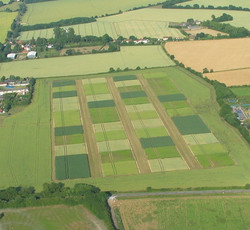Shallow tillage systems are producing soils with a higher resistance to penetration which could potentially restrict rooting and the ability of the crop to fully exploit the soil profile, warns NIAB TAG.
Results from NIAB TAG’s STAR Project, now in its ninth year, have highlighted changes in soil characteristics between differing cultivation approaches in the study.
The STAR Project, based near Otley in Suffolk, compares four different cultivation methods - plough, deep and shallow non-inversion, and a managed approach where decisions are made annually based on field assessments. The study also compares four different rotations based around winter cropping, spring cropping, continuous wheat and alternate wheat / fallow rotations. This forms part of a fully factorial design delivering 16 treatments.
Dr Nathan Morris, NIAB TAG’s soils and farming systems specialist, speaking at the STAR Project Open Day, told farmers the research so far indicates that shallow tillage approaches are continuing to exhibit increasing soil strength, perhaps exacerbated by limited mechanical alleviation of consolidation at depth.
“Wider research has suggested that there is a strong correlation between soil strength and root growth rate. Root growth rates can halve as soil penetration resistance increases to 1 MPa, and at some point between soil penetration resistance of 3 and 4 MPa most roots cease to grow or are growing so slowly as to add little to root function.”
Dr Morris also demonstrated that detailed analysis of longer term trends in cultivation and rotation from the study suggests, when looking at outputs across all crops in general, ploughing is tending to result in the greatest yields, but not the highest margins.
“When comparing the four cultivations systems over all crops the deep system is typically giving a higher return, although the deep and managed approaches are very similar. The shallower system tends to perform less well.” 
However, Dr Morris warned that if wheat crops only are considered in the rotation the findings are currently indicating very little difference in mean yield between plough, deep and shallow systems; although there are again suggestions that the deep system is giving higher margins.
Grass weed problems in the STAR Project include brome and black-grass. NIAB TAG weed specialist John Cussans highlighted how rotation, including the use and choice of spring crops, and cultivation strategies are important in managing these grass weeds.
This year’s break crop options of oilseed rape in the winter rotation and oats in the spring cropping work has shown that spring cropping can provide useful opportunities for grass weed management.
The STAR Project also provides an opportunity to look at how the specific systems interact to give differences in yield and financial performance. In 2012/13 the difficult wet autumn impacted on winter wheat establishment and crop performance and the highest crop yields were achieved in winter wheat with 9.5 t/ha, using the ‘managed’ approach in the spring cropping rotation.
The STAR Project is a fully replicated project undertaken on a heavy (Hanslope) clay soil in Suffolk, using farm scale equipment and techniques. The research is delivered through NIAB TAG supported by the Felix Cobbold Trust and The Chadacre Agricultural Trust and also forms part of a larger HGCA funded ‘Soils Platforms’ study, HGCA project 3786.
